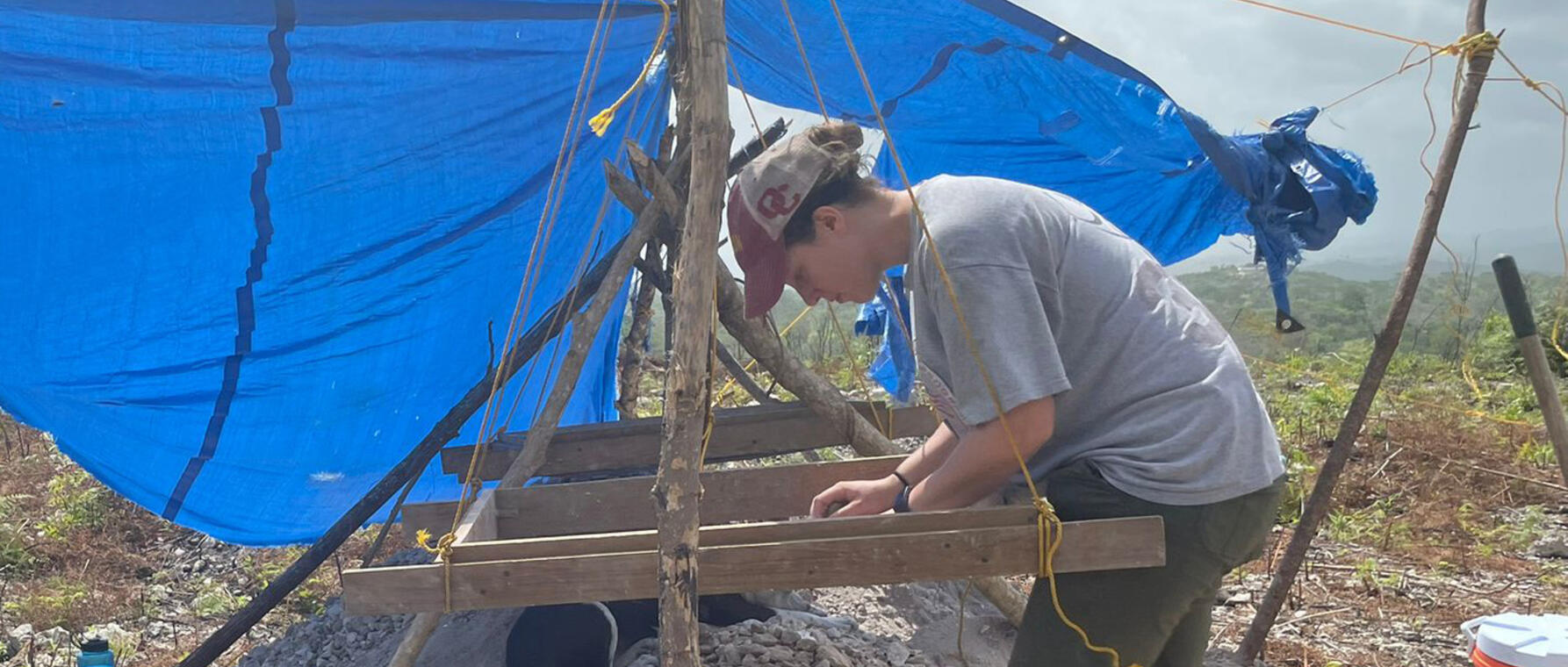Looking to the Past to Prevent the Next Pandemic
How biology and archeology combine in the quest to track the path of pathogens

Research at Risk: Since World War II, universities have worked with the federal government to create an innovation ecosystem that has yielded life-changing progress. Now much of that work may be halted as funding is withdrawn. Find out more about the threats to medical, engineering, and scientific research, as well as how Harvard is fighting to preserve this work—and the University's core values.
Before she was a graduate student, Megan Michel worked as an ancient DNA technician. She would don a Tyvek full-body suit, several layers of gloves, a face mask, goggles, and rubber boots, and begin drilling into an ancient bone to extract a bit of powder. The human DNA from such samples holds important genetic information that can help scientists better understand societies of the ancient past.
However, what most excites Michel, who will receive her PhD in human evolutionary biology from the Harvard Kenneth C. Griffin Graduate School of Arts and Sciences (GSAS) in November, is not the DNA of humans, but of ancient pathogens. She studies the DNA of ancient microorganisms to better understand what sickened people who lived thousands of years ago. It’s a challenging task. Prolonged environmental exposure often means that very little pathogen DNA survives in skeletal remains—hence the gear technicians wear to prevent contaminating the samples they draw from ancient bones.
“Before the advent of DNA sequencing in genomic analyses, archaeologists interested in studying historical diseases were constrained to those infections that left visible lesions on the bones, such as tuberculosis or leprosy,” Michel says. “But most diseases leave no apparent signs on skeletal remains. With DNA sequencing, we can point to a specific causative organism that infected a person at their time of death.” The discoveries that Michel and her colleagues make about the past through this painstaking work may well shape humanity’s ability to deal with the pandemics of the future.
Fishing for Malaria

Each year, Plasmodium falciparum, the deadliest of the parasites that cause malaria, is responsible for around 225 million cases of the disease and over half a million deaths—mostly of pregnant women and children in Africa. Because the pathogen is so virulent and lethal for young children, it has exercised an enormous influence on the human genome. If scientists could determine which species of malaria were present at different points in history, they could better understand the evolutionary pressures that led to biological adaptations conferring resistance to it, such as sickle cell disease. Right now, though, scientists lack DNA samples that would allow them to trace which species of malaria-causing organism were present at different points in history.
That’s where Michel’s research comes in. Conducted jointly at Harvard and the Max Planck Institute for Evolutionary Anthropology in Leipzig, Germany, Michel’s PhD dissertation “deploys novel microbiological methods to detect and analyze ancient pathogens for periods when historical records rarely allow us to identify diseases and their impact,” says Michael McCormick, the Francis Goelet Professor of Medieval History and co-director of the Max Planck-Harvard Research Center for the Archaeoscience of the Ancient Mediterranean (MHAAM), which acts as a bridge between the University and the institute—and where Michel is a fellow.
In the case of malaria, Michel uses a technique called hybridization capture to enrich ancient DNA libraries with the genetic material of the malaria parasite. “We designed a capture reagent that consists of a set of DNA baits that are complementary to the malaria genomes that we want to study,” she explains. “These baits are bound to tiny magnetic beads, and when we perform capture in the lab, we can use them to physically fish out the DNA fragments that we are interested in.”
With DNA sequencing, we can point to a specific causative organism that infected a person at their time of death.
—Megan Michel
The DNA samples may help Michel date ancient strains and uncover what occurred to facilitate the mutations that led to malaria’s zoonotic (animal to human) jump. “If we assume that sequences accumulate mutations at a constant rate, we can try to calculate the age of particular pathogenic lineages, like the species that cause infections in humans today,” she says. “Ancient DNA helps to make these estimates more precise because the samples can be dated using radiocarbon dating or archaeological context. A precise date would allow us to explore cultural, ecological, and environmental factors that might have facilitated zoonosis.”
Current theories suggest that Plasmodium falciparum emerged in great apes around the time that agriculture spread in Sub-Saharan Africa. “The idea is that humans interacted with the landscape in new ways that facilitated mosquitos transmitting malaria,” Michel says. “High population densities associated with groups living permanently in one place may also have been necessary to sustain such a virulent pathogen. Our hope would be to use ancient DNA to explore a hypothesis like this further.”
From the Black Plague to Tooth Decay
As important as it is to understand malaria, the value of studying ancient pathogens extends beyond one disease. DNA sequencing reveals, for example, that Yersinia pestis, the pathogen behind the bubonic plague that wiped out about half of Europe’s population during the fourteenth century, existed at the dawn of the Bronze Age 5,000 years ago—far earlier than previously believed. DNA sequencing also shows that this ancient plague differed in essential ways from later strains.
“The plague that caused the Black Death and the Justinianic Plague adapted for transmission by fleas that fed on rodents, including the black rat,” Michel says. “Strains from the Late Neolithic and Bronze Age seem to lack genes facilitating flea-borne transmission, creating interesting questions about how plague did spread during these earlier time periods.”
One of the other pathogens Michel studies is Streptococcus mutans, an oral microbe that breaks down dietary carbohydrates, producing acids that contribute to the development of dental caries (tooth decay). After humans transitioned to agriculture, a process that began around 12,000 years ago in the Near East, there was an increase in caries due to greater consumption of carbohydrates. Going into the study, Michel theorized that Streptococcus mutans evolved to break down carbohydrates after societies shifted to farming. But her work reveals that the story is far more complicated.
“Genomic analyses suggest that some ancient microbes were already capable of breaking down carbohydrates even before the transition to agriculture,” she says. “This suggests that the history of human dental caries had more to do with the interactions between human diets and microbes of the mouth than biological changes in the microbes themselves. Increasingly, people believe that dental caries are the result of complex ecological processes in the oral cavity rather than “infection” by a single pathogenic species, like S. mutans. Our finding that many of the virulence factors present in S. mutans today actually predate the adoption of agricultural diets fits well with this more nuanced view for the causes of tooth decay.”
Megan’s PhD research on ancient malaria—in which she detects the pathogen in dozens of ancient people including people living in places where the disease is not endemic—is particularly groundbreaking and points the way to all sorts of follow-up research today.
—Professor David Reich
The shift to agriculture had radical consequences for human health beyond increased tooth decay. The ability to stockpile food meant increased populations, more sedentary lifestyles, and more people living in confined spaces. The greatest impact on human health, however, might have been the greater proximity to animals, which increased the opportunities for infectious diseases because many, if not most, are zoonotic. The study of oral microbes, and ancient DNA more generally, helps add valuable historical context to how humans, environments, and pathogens interacted.
Preparing for the Next Pandemic
Understanding the historical and genetic contexts behind past zoonotic events, like Michel’s work on malaria, could be instrumental in anticipating emerging infectious diseases in the future. “The SARS‑CoV‑2 virus—the cause of the global pandemic that claimed at least 3.4 million lives worldwide—jumped from an animal to a human,” Michel points out. Armed with this knowledge, public health officials can design interventions to mitigate—or even eliminate—the spread of deadly diseases.
“Many people probably aren't aware that malaria was endemic across most of Europe only fifty years ago,” Michel says. “There was malaria all the way up into Scandinavia. Now, it’s been eradicated thanks to huge public health interventions.”
“There have been so many extraordinary achievements of MHAAM, but supporting students was always the core, and creating the mechanism that allowed Megan Michel to do the work she has done is arguably the initiative’s greatest success,” says David Reich, professor of genetics and human evolutionary biology at Harvard, in whose laboratory Michel was a research technician before she started as a graduate student. “Megan’s PhD research on ancient malaria—in which she detects the pathogen in dozens of ancient people including people living in places where the disease is not endemic—is particularly groundbreaking and points the way to all sorts of follow-up research today,” says Reich.
As she reflects on where the science of the human past is headed, Michel is hopeful about the range of disciplines collaborating in the field. “Right now, research is coming from a lot of different backgrounds like computer science, biology, archaeology—even from history,” she says. “As we get more samples of ancient genomes, our understanding of how infectious disease evolves will only increase. As the COVID-19 pandemic shows, that knowledge is going to be really important in the future.”
Get the Latest Updates
Join Our Newsletter
Subscribe to Colloquy Podcast
Simplecast





